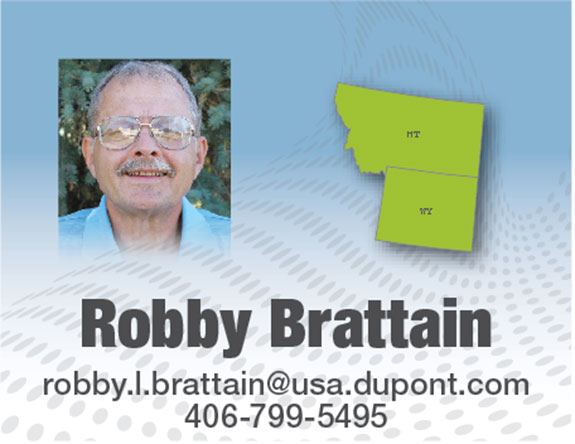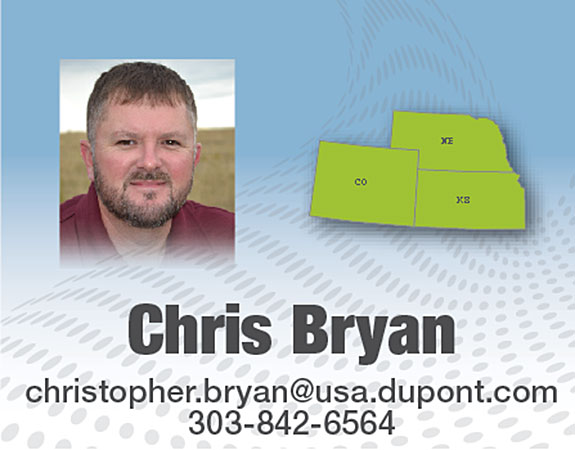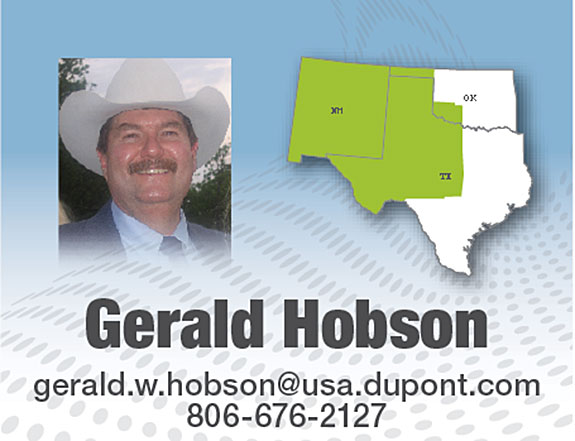North-Central Summary
In many parts of the country, pastures and rangeland are still recovering from several years of drought.
Lack of a reliable forage supply meant overgrazing was common last year, says Katie Conklin, DuPont range and pasture specialist for North Dakota and South Dakota.
“It’s very important for those areas to have adequate time for desirable grasses to regrow and re-establish. It’s also essential to control weeds that compete with those desirable grasses.”
Identifying key weed pressures and making a timely early summer application can be an effective tool in helping rebuild pastures and rangeland, adds Chris Bryan, DuPont range and pasture specialist for Nebraska, Kansas and Colorado.
“It’s an investment that can help lay the foundation for better pasture conditions for seasons to come.”
South-Central Summary
Whether your pastures are recovering from drought or have had enough moisture, late spring and early summer are good times to fine-tune your pasture management.
Look for any weed escapes from a spring herbicide application, scout for warm-season perennial weeds, and consider the value of another fertilizer application to hay fields after a second cutting, recommends Jack LeClair, DuPont range and pasture specialist for east Texas and Oklahoma.
“When input budgets are tight, studies have shown your money is best spent controlling weeds first, then fertilizing when the budget allows.”
There is real value in a rescue treatment for tough weeds such as annual broomweed and thistles, adds Gerald (G.W.) Hobson, DuPont range and pasture specialist for west Texas, southwestern Oklahoma and New Mexico.
“While controlling weeds early is ideal, it’s better to control large weeds than to let them form a canopy that shades grasses. Studies show that an effective herbicide application can significantly increase grass production.”
West Summary
Drought and wildfires damaged pastures and rangeland in 2012, making management this season more important than ever.
“With less grazeable land, ranchers need to make the most of grasslands they have,” says Nevin DuPlessis, DuPont range and pasture specialist for Washington, Oregon, Idaho, Utah and Nevada.
“Weed control is an important part of maximizing grass production, and that’s especially true after drought.”
Broadleaf weeds, forbs and shrubs are especially aggressive early in the season and can easily get the jump on grasses that are just starting to recover, adds Robby Brattain, DuPont range and pasture specialist for Montana and Wyoming.
“An investment in weed control this season could pay dividends in grass production for several years.”
 Robby Brattain
Robby Brattain
Advice for North-Central, WestDrought conditions often lead to overgrazing, which can weaken grass roots by depleting their energy.
Moisture and time are essential for grass recovery. That might mean minimal grazing this season on those pastures and rangeland most affected by drought.
It would be ideal to let those pastures go to seed this year. But when that’s not an option, reduced grazing times will help.
Weed control is also an essential tool for reducing competition with those weakened grasses.
After drought, broadleaf weeds, forbs and brush species tend to grow and reach moisture ahead of grasses.
You’ve probably already seen growth of snowberry, fringed sagebrush and aggressive alyssum species with spring moisture.
While small amounts of some forbs and brush species are acceptable, current conditions could allow them to get ahead of grasses and limit pasture recovery.
While plants are still green, an application of broadleaf herbicide on woody plants such as snowberry or on fringed sagebrush will provide reliable, season-long control in this critical recovery year and beyond.
With adequate moisture this season, the real impact could be seen next spring when new grass seedlings are more likely to emerge and existing plants should become more vigorous.
 Katie Conklin
Katie Conklin
Advice for North-Central
If you haven’t had time to scout pastures and rangeland yet this season, now is a good time to look for perennial weeds such as Canada thistle, absinth wormwood and leafy spurge.
These weeds tend to be harder to control than annual varieties, and herbicide application timing is critical to getting effective control.
Leafy spurge, for example, is best controlled in the bloom stage, while Canada thistle should be controlled prior to blooming.
An application of broadleaf herbicide is effective in suppression of Canada thistle.
If you spot buckbrush (western snowberry) in your pastures, June is also a good time to control this perennial forb.
Reproducing by seed and rhizome, it typically grows in the most productive areas of pasture and rangeland, so it may be having more impact on pasture quality than you realize.
A tank mix of broad spectrum control herbicide and 2,4-D applied after buckbrush leaves have emerged but before they harden off can provide season-long control.
Some weed species have reappeared in the Dakotas recently mainly due to the dry conditions, including curlycup gumweed, a short-lived perennial that stands 1 to 3 feet high and has bright yellow flowers.
The time to control curlycup gumweed is before it flowers in July.
With any unfamiliar weeds, it’s important to accurately identify them and determine the best stage for control, then talk to your crop consultant or crop protection product retailer to determine the most effective herbicide for the job.
 Chris Bryan
Chris Bryan
Advice for North-Central, West, South-Central
Much of our region continues to recover from drought. In order to rebuild pastures and rangeland, you may need to make some changes to your management techniques and timing this season.
Overgrazing was a common occurrence last year, so many pastures may need more time to allow plants to recover.
Since overgrazing opens the soil to more sunlight, soils get hotter and often more packed around the root base.
Shortening grazing periods and rotating cattle more frequently will help to minimize stress on grasses and allow them to rebuild root reserves.
Overgrazing also leads to increased weed pressure, as weakened grass plants become less competitive with weed species for space, water and nutrients.
Since bigger weeds are harder to control, it’s important to scout pastures early this summer and make timely herbicide applications while weeds are still small.
Strategic herbicide applications can help to more than double your yearlong forage production, provided there is adequate moisture.
Also be on the lookout for new weed species. All the hay that’s been brought into the area due to the drought could have also brought along new weeds.
It’s important to identify any unfamiliar species early, then work with local range and pasture specialists to determine the best time and method for control.
 Jack LeClair
Jack LeClair
Advice for North-Central, West, South-Central
This year’s moisture has helped grasses start to recover from multi-year drought in many parts of our area.
Key management practices to help that recovery are good weed control, fertilizing when possible and avoiding overgrazing.
We saw a lot of overgrazing last season due to severe forage shortages, and as a result, those pastures are still in rough shape this year.
A good rule of thumb is to graze half and leave half.
If you have 8 inches of grass, graze it down to about 4 inches and leave an average of 4 inches to avoid stressing grass plants.
To avoid overgrazing, many ranchers relied on new sources to meet their forage needs. The increased amount of hay brought into the region during the drought may have transported new weed species.
They may also have been introduced when cattle were moved or by feral hogs. If you see unfamiliar weeds this season, it’s important to identify them, then work with local range and pasture specialists to determine the best time and method for controlling them.
When planning strategic herbicide applications, remember to time them according to soil temperature, not the calendar.
There can be significant differences from year to year when it comes to soil warming and weed seed germination. Knowing when different species germinate is essential.
For instance, woolly croton tends to be a mid-season to late-season weed problem in Texas and Oklahoma, but it germinates at 82 degrees.
In a dry summer like last year, soils had less plant cover and tended to heat up sooner than usual, so woolly croton was a problem earlier than is typical in some areas.
Soil temperatures vary within a field as well, and weeds usually germinate on higher ground sooner than in lower areas.
For control of broadleaf weeds, it’s important to use an herbicide with soil residual. Last summer, for example, we saw a flush of weeds after the late-season rains. The right early summer herbicide application can also provide season-long control.
 Matt McGowin
Matt McGowin
Advice for North-Central, South-Central
This season’s higher beef prices are encouraging, but a key to profitability is maximizing your grass production.
The grass in your pastures is the least expensive feed for your herd, so it’s well worth your time to scout and manage pastures more carefully this summer.
Along with rotational grazing and proper fertilization, weed control is one of the most important management tools you have.
Effective weed control offers a good return on investment by reducing competition for grasses and allowing them to flourish.
You don’t want to feed weeds, so eliminating them prior to fertilizing pastures makes sense. It’s better to be proactive than reactive, especially with weeds such as dogfennel and woolly croton.
If you don’t control them when they’re young, they can really get out of hand. A well-timed application of post-emergence control herbicide can provide excellent control of these problem broadleaf weeds and offer residual control throughout the summer.
In bermudagrass, even if you missed controlling weeds in the spring, it’s not too late. An application of bermudagrass herbicide seven to 14 days after a hay cutting will provide good control of species such as broadleaf signalgrass, barnyardgrass and johnsongrass.
 Gerald Hobson
Gerald Hobson
Advice for West, South-Central
With many parts of the region still suffering from lack of moisture, controlling weeds this season is crucial to pasture and rangeland recovery.
Now is a good time to assess your spring herbicide performance and to catch any spring weed escapes.
It’s also the time to scout for warm-season perennials that might be poisonous to livestock.
Broom snakeweed, horse nettle and silverleaf nightshade might be the only green vegetation in those pastures.
An early application of a post-emergence control herbicide with a good-quality adjuvant and a minimum of 3 gallons of water per acre can provide suppression of these species as well as moisture-robbing brush species such as mesquite.
If brush has become a bigger problem in recent dry years, consider spot treatments of an herbicide designed for tougher weeds in established stands.
Tracking rainfall on your ranch and understanding basic weed physiology will help you forecast weed challenges.
For instance, last year’s October and November rains in the region allowed broomweed to germinate and thistles to grow. It was predictable that both would be tremendous problems this spring.

Frank Jones
Advice for South-Central
Summer grass and pasture management is about maximizing production.
Scouting for weeds is an important part of producing quality hay and catching them while they’re small and growing ensures better control.
To control broadleaf weeds and invasive grasses in bermudagrass pastures such as Pensacola bahiagrass and johnsongrass, or suppression of those such as vaseygrass, an application of 1 to 1.5 ounces per acre of bermudagrass herbicide applied five to seven days after a cutting is an excellent solution.
It’s also effective in controlling sandbur, which has become a problem weed in some areas.
Scouting fields a few days after a cutting is a good time to identify weeds and their severity. If there are a few now, there will be more later, so early control is always most effective.
There can also be value in making a late-summer or early fall herbicide application. Bermudagrass herbicide can also be applied in late September or early October to control late-season weeds as well as provide residual control of winter annuals such as henbit.

Nevin DuPlessis
Advice for West
Wildfires burned some 700,000 acres of forest and rangeland in parts of Nevada, Utah and Idaho last year, much of which won’t be grazeable again for several years.
Making the most of existing grasslands will be very important this season.
Scouting pastures and rangeland after drought is important, and a thorough evaluation requires more than just driving by.
Plan to get out of the truck and walk around to assess grass populations and weed pressures.
Look for poisonous weeds such as poison hemlock, yellow starthistle and houndstongue, as well as new weed species that may have come in with imported hay or animals.
Work with your local range and pasture specialist to identify them and determine the best type of control.
Long-rooted weeds, including thistles, do well in drought years. So do curly dock, whitetop and multiflora rose.
An application of herbicide for post-emergence control and broadleaf suppression will control these and nearly 100 other weed species that could be competing with grasses.
Studies show that you’ll gain 1 pound of grass for every pound of weed you control. And when compared to the cost of buying hay, a $15- to $20-per-acre herbicide application can be a very good value. ![]()
PHOTO
Effective weed control offers a good return on investment by reducing competition for grasses and allowing them to flourish. Staff photo







